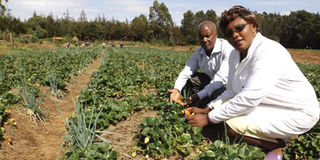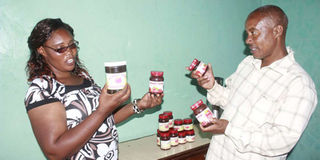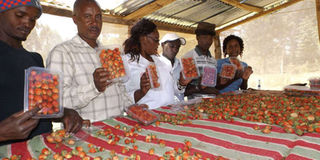Premium
From farm to supermarket: Strawberries bear big fruit for couple

Kenneth Kinuthia and his wife Beth Kinuthia in their strawberry farm named Kenbet Farm, in Oljoro Orok, Nyandarua County. The couple grows the Chandler variety of strawberries, which according to them is bigger, sweeter and has a longer shelf-life. PHOTO | JOHN GITHINJI | NATION MEDIA GROUP
What you need to know:
- Strawberry farming is profitable as long as one has market. The fact that it is used in blending other foods makes it a much-sought after fruit.
- Since the strawberry plant grows close to the ground, it is often attacked by diseases such as botrytis.
- There are two ways of growing strawberry depending on the variety, which is through seeds or through transplanting strawberry runners or splits.
- Kenneth and Beth grow the sweet fruit and add value to it by packaging and making jam which they sell to a supermarket in a fruitful business model.
A sea of green plants dotted with small red fruits stretch on the two-acre farm on the slopes of the Aberdare Ranges in Kinangop, Nyandarua County forming a beautiful site.
Standing on the edge of the farm are Kenneth Kiarie, 46, and his wife Beth, 36.
The two are the owners of the farm, growing strawberries that they later process into jam and also sell as branded fruits.
“Currently, we are harvesting from one-and-a half acres of productive strawberry heads. We harvest three times a week getting 140kg of the fruits,” says Kiarie.
A kilo of strawberry fruits goes at an average of Sh400. “Most of those we sell to fresh fruits come on the farm directly buying about half of our produce. The rest of the fruits we package and sell to supermarkets and add value on others.”
The couple grows the Chandler variety, which according to them is bigger, sweeter and has a longer shelf-life.
There are two ways of growing strawberry depending on the variety, which is through seeds or through transplanting strawberry runners or splits.
“For us we grow splits which is what the Chandler variety offers. Currently, we have more than 10,000 splits that can be transplanted for new farm establishment.
After transplanting the splits in well fertilised soils, we constantly water them until when they get out of dormancy and start producing new leaves,” explains Beth.
PESTS AND DISEASE CHALLENGES
Each strawberry mother plant has an average of 10 splits, which reach fruit bearing age at about eight months and the plant continues to fruit all-year-round.
During planting, good spacing is vital for optimum health of the strawberry plant.
“We plant the fruits in a zigzag manner to limit contact between plants to curb diseases. But the plants must be at two feet between each other and one foot between rows,” says Beth, adding they apply 17kg of animal manure per bed.
After every six months, the beds are replenished with manure and soil stabilisers which help check the pH level that affects the sweetness of the fruit.
Since the strawberry plant grows close to the ground, it is often attacked by diseases such as botrytis.
“We mulch the plants and carry out regular pruning of old leaves that are close to the ground to curb the disease,” Kiarie says.

The couple display some of the products they make from value addition of their strawberries. PHOTO | JOHN GITHINJI | NATION MEDIA GROUP
Besides the environmental diseases that can easily be mitigated by good agronomic practices, birds are also a menace, therefore, the farmers cover the plants with nets when they are fruiting.
“Snails also like the dump ground below the plant caused by constant watering. To eradicate the snail problem, we plant spring onions whose smell repels the pest leaving us with clean fruits,” says the farmer.
A strawberry plant can produce for more than five years but it loses its production vigour as it ages.
“We make sure we get the most out of our plants before we uproot them by harvesting maximum fruits and splits. The plant’s productivity can last over five years, with each producing an average of five fruits daily for not less than three years depending on how fertilised and watered the soil is.”
AMPLE LIGHT AND WARM TEMPERATURE
Some people grow strawberries in greenhouses, but according to the couple, the plant requires ample light and warm temperatures for optimum production.
“We prefer the open field design because of quality fruit despite challenges like birds that destroy the produce.”
At harvesting, different grades of fruits emerge, with some big while others small.
“We wash, dry and package the bigger fruits for the supermarket while we use the smaller ones to make strawberry jam,” says the couple, whose products are branded Kenbet Strawberry Jam and Kenbet fruits, which are approved by the Kenya Bureau of Standards and are sold at Naivas supermarket.
To make the jam, Beth says while they use smaller fruits that would otherwise not fetch much in the market, they ensure they are of good quality.
“We start by cleaning the fruits with plenty of water after removing the stem part which is green. The cleaned berries are then placed in a large tray where they are handpicked and sliced into a blender. The blended berries are then put in a specialised stove which heats them at above 200 degrees Celsius to dehydrate to a pulp. We then add sugar and mix thoroughly.”
The pulp is cooled before being packaged in clean branded containers and taken to the market.
“The jam business is lucrative although our production level is low for now since we only stock the jam that goes for 250g at Sh150 in one supermarket,” says Kiarie, who employs 15 people.

The couple with some of their employees display packaged strawberries in the farm. They have employed 15 people in their agribusiness. PHOTO | JOHN GITHINJI | NATION MEDIA GROUP
But as they savour success in the strawberry business which they started in 2012, it has not been an easy journey.
“I started business in late 1990s by selling timber but things became tough when government tightened controls on logging which saw most of the time my products impounded by security officials. This led to collapse of the business,” recounts Kiarie.
MONEY IN AGRIBUSINESS
Meanwhile, as the business was going under, Beth had started growing cabbages and carrots on the two acres Kiarie inherited from his parents.
The cabbages did well and Beth sought market where she found a buyer who gave her a lucrative price of Sh12 per head.
“This was a good offer back in 2006. She sold 3,000 heads in the first sale and 2,000 heads in the second to a buyer from Maralal making us realise there is money in agribusiness,” recounts Kiarie.
Their next crop was snow peas, which was fetching Sh40 per kilo and was deemed profitable leading to a craze in the region.
The peas led to the formation of a self-help group through which farming experts were invited to address them.
“One day one of the experts, a Mr Githire talked to us about strawberry farming. We got interested and bought 2,000 splits from him worth Sh60,000 on credit which we planted with his help,” says Beth, noting the first crop did not perform well.
PROFITABLE CROP
More trouble awaited them after harvesting since they did not have market.
“Our children would eat the strawberry to their fill and we also offered some to our cows,” Kiarie remembers, adding they resorted to package and hawk the fruits in Nyandarua and other neighbouring towns.
The door-to-door hawking brought numerous challenges and they had to look for an easier way to market the product. It is then that they approached companies that packaged the fruits for supermarket outlets.
“We got orders upon inquiry and our businesses has grown since then,” says the couple, adding that they are currently working on increasing the production of jam which is lucrative. Their secret to sucess they says is resilience.
David Gichuki, Kinangop sub-county agricultural officer, says that a farmer can harvest up to 20,000kg from an acre of strawberry in just eight months, highlighting how profitable the crop is.
“Strawberry farming is profitable as long as one has market. The fact that it is used in blending other foods makes it a much-sought after fruit,” he says, noting when a farmer adds value to the produce it brings in more money than selling raw fruits.
***
Journey to Supermarket
- Product must be certified by the Kenya Bureau of Standards and have a bar code certificate for the automated cash machines
- To get the certificate from the standards body, one applies to be authorised to operate jams and kellies business. Once authorised, the process of certification starts where the officials from the body visit the premises and inspect the production area and carry samples for analysis.
- If you pass the test, Kenya Bureau of Standards give your certificate which means that the product is safe for the market.




